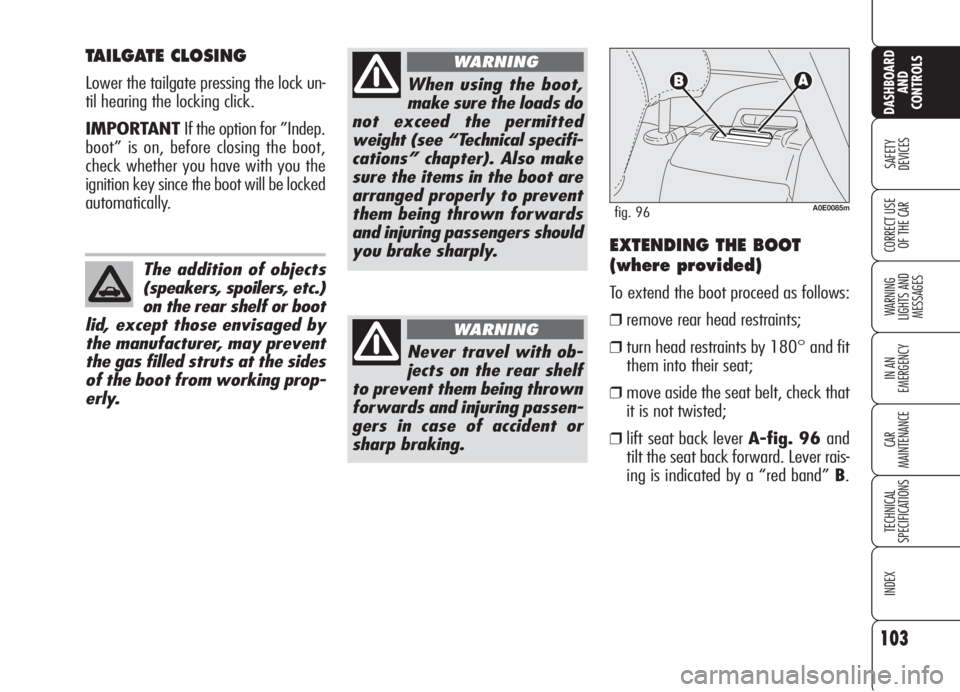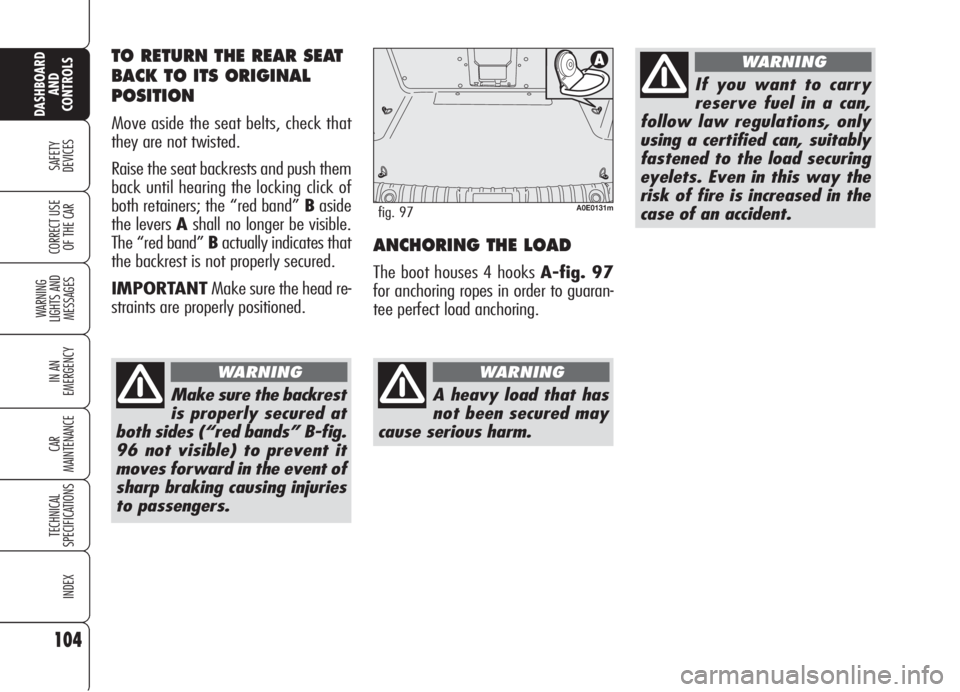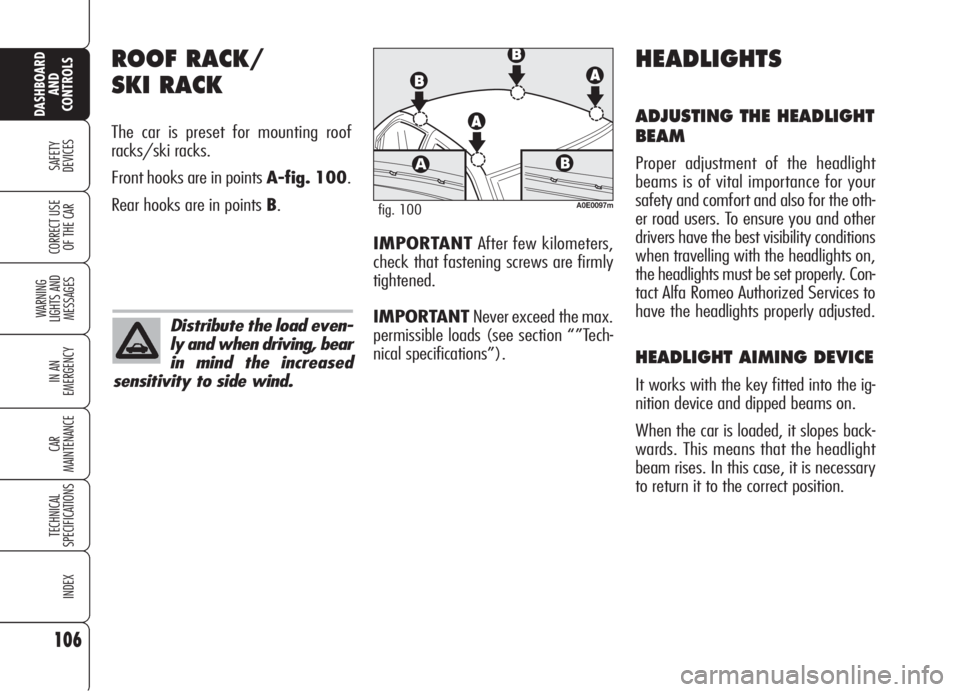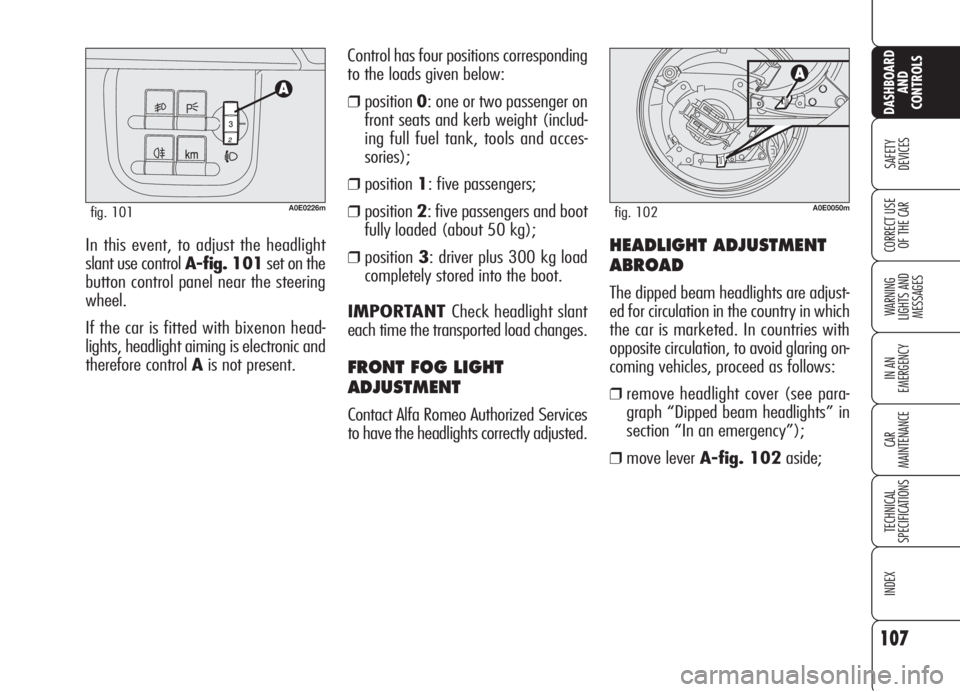head lights Alfa Romeo 159 2006 Owner handbook (in English)
[x] Cancel search | Manufacturer: ALFA ROMEO, Model Year: 2006, Model line: 159, Model: Alfa Romeo 159 2006Pages: 299, PDF Size: 4.64 MB
Page 84 of 299

82
SAFETY
DEVICES
WARNING
LIGHTS AND
MESSAGES
IN AN
EMERGENCY
CAR
MAINTENANCE
TECHNICAL
SPECIFICATIONS
INDEX
CORRECT USE
OF THE CAR
DASHBOARD
AND
CONTROLS
Resetting the power supply
cut-off switch
(where provided)The switch is located inside the fuse box
at battery positive terminal.
To reset the power supply cut-off switch,
proceed as follows:
❒press button A-fig. 61to reset the
fuel cut-off switch;
❒open the bonnet;
❒operate the retaining clips A-fig. 62
and remove the protection cover B;
❒press buttonC-fig. 63to reset the
power supply cut-off switch.
A0E0126mfig. 62
Before resetting the
power supply cut-off
switch carefully inspect the car
for fuel leaks or damages to
electric devices (e.g. head-
lights).
WARNING
A0E0071mfig. 63
Resetting the fuel cut-off
switch
Before resetting the fu-
el cut-off switch care-
fully inspect the car for fuel
leaks or damages to electric
devices (e.g. headlights).
WARNING
To reset the fuel cut-off switch, press but-
tonA-fig. 61.
A0E0221mfig. 61
Page 105 of 299

103
SAFETY
DEVICES
WARNING
LIGHTS AND
MESSAGES
IN AN
EMERGENCY
CAR
MAINTENANCE
TECHNICAL
SPECIFICATIONS
INDEX
CORRECT USE
OF THE CAR
DASHBOARD
AND
CONTROLS
TAILGATE CLOSING
Lower the tailgate pressing the lock un-
til hearing the locking click.
IMPORTANT If the option for ”Indep.
boot” is on, before closing the boot,
check whether you have with you the
ignition key since the boot will be locked
automatically.
The addition of objects
(speakers, spoilers, etc.)
on the rear shelf or boot
lid, except those envisaged by
the manufacturer, may prevent
the gas filled struts at the sides
of the boot from working prop-
erly.
When using the boot,
make sure the loads do
not exceed the permitted
weight (see “Technical specifi-
cations” chapter). Also make
sure the items in the boot are
arranged properly to prevent
them being thrown forwards
and injuring passengers should
you brake sharply.
WARNING
Never travel with ob-
jects on the rear shelf
to prevent them being thrown
forwards and injuring passen-
gers in case of accident or
sharp braking.
WARNING
EXTENDING THE BOOT
(where provided)
To extend the boot proceed as follows:
❒remove rear head restraints;
❒turn head restraints by 180° and fit
them into their seat;
❒move aside the seat belt, check that
it is not twisted;
❒lift seat back lever A-fig. 96 and
tilt the seat back forward. Lever rais-
ing is indicated by a “red band” B.
A0E0085mfig. 96
Page 106 of 299

104
SAFETY
DEVICES
WARNING
LIGHTS AND
MESSAGES
IN AN
EMERGENCY
CAR
MAINTENANCE
TECHNICAL
SPECIFICATIONS
INDEX
CORRECT USE
OF THE CAR
DASHBOARD
AND
CONTROLS
ANCHORING THE LOAD
The boot houses 4 hooks A-fig. 97
for anchoring ropes in order to guaran-
tee perfect load anchoring.
A0E0131mfig. 97
A heavy load that has
not been secured may
cause serious harm.
WARNING
If you want to carry
reserve fuel in a can,
follow law regulations, only
using a certified can, suitably
fastened to the load securing
eyelets. Even in this way the
risk of fire is increased in the
case of an accident.
WARNINGTO RETURN THE REAR SEAT
BACK TO ITS ORIGINAL
POSITION
Move aside the seat belts, check that
they are not twisted.
Raise the seat backrests and push them
back until hearing the locking click of
both retainers; the “red band” Baside
the levers Ashall no longer be visible.
The “red band” Bactually indicates that
the backrest is not properly secured.
IMPORTANTMake sure the head re-
straints are properly positioned.
Make sure the backrest
is properly secured at
both sides (“red bands” B-fig.
96 not visible) to prevent it
moves forward in the event of
sharp braking causing injuries
to passengers.
WARNING
Page 108 of 299

106
SAFETY
DEVICES
WARNING
LIGHTS AND
MESSAGES
IN AN
EMERGENCY
CAR
MAINTENANCE
TECHNICAL
SPECIFICATIONS
INDEX
CORRECT USE
OF THE CAR
DASHBOARD
AND
CONTROLS
ROOF RACK/
SKI RACK
The car is preset for mounting roof
racks/ski racks.
Front hooks are in points A-fig. 100.
Rear hooks are in points B.
A0E0097mfig. 100
HEADLIGHTS
ADJUSTING THE HEADLIGHT
BEAM
Proper adjustment of the headlight
beams is of vital importance for your
safety and comfort and also for the oth-
er road users. To ensure you and other
drivers have the best visibility conditions
when travelling with the headlights on,
the headlights must be set properly. Con-
tact Alfa Romeo Authorized Services to
have the headlights properly adjusted.
HEADLIGHT AIMING DEVICE
It works with the key fitted into the ig-
nition device and dipped beams on.
When the car is loaded, it slopes back-
wards. This means that the headlight
beam rises. In this case, it is necessary
to return it to the correct position.
Distribute the load even-
ly and when driving, bear
in mind the increased
sensitivity to side wind.
IMPORTANTAfter few kilometers,
check that fastening screws are firmly
tightened.
IMPORTANTNever exceed the max.
permissible loads (see section “”Tech-
nical specifications”).
Page 109 of 299

107
SAFETY
DEVICES
WARNING
LIGHTS AND
MESSAGES
IN AN
EMERGENCY
CAR
MAINTENANCE
TECHNICAL
SPECIFICATIONS
INDEX
CORRECT USE
OF THE CAR
DASHBOARD
AND
CONTROLS
In this event, to adjust the headlight
slant use control A-fig. 101set on the
button control panel near the steering
wheel.
If the car is fitted with bixenon head-
lights, headlight aiming is electronic and
therefore control Ais not present.Control has four positions corresponding
to the loads given below:
❒position0: one or two passenger on
front seats and kerb weight (includ-
ing full fuel tank, tools and acces-
sories);
❒position1: five passengers;
❒position2: five passengers and boot
fully loaded (about 50 kg);
❒position3: driver plus 300 kg load
completely stored into the boot.
IMPORTANT Check headlight slant
each time the transported load changes.
FRONT FOG LIGHT
ADJUSTMENT
Contact Alfa Romeo Authorized Services
to have the headlights correctly adjusted.
A0E0226mfig. 101
HEADLIGHT ADJUSTMENT
ABROAD
The dipped beam headlights are adjust-
ed for circulation in the country in which
the car is marketed. In countries with
opposite circulation, to avoid glaring on-
coming vehicles, proceed as follows:
❒remove headlight cover (see para-
graph “Dipped beam headlights” in
section “In an emergency”);
❒move lever A-fig. 102aside;
A0E0050mfig. 102
Page 137 of 299

135
WARNING
LIGHTS AND
MESSAGES
IN AN
EMERGENCY
CAR
MAINTENANCE
TECHNICAL
SPECIFICATIONS
INDEX
CORRECT USE
OF THE CAR
DASHBOARD
AND
CONTROLS
SAFETY
DEVICES
The results of research on the best child
restraint systems are contained in the
European Standard ECE-R44. This Stan-
dard enforces the use of restraint sys-
tems classified in five groups:
Group 0 - 0-10 kg in weight
Group 0+ - 0-13 kg in weight
Group 2 9-18 kg in weight
Group 2 15-25 kg in weight
Group 3 22-36 kg in weight
As it may be noted, the groups overlap
partly and in fact, in commerce it is pos-
sible to find devices that cover more
than one weight group.
All restraint devices must bear the cer-
tification data, together with the control
brand, on a solidly fixed label which
must absolutely never be removed.
Over 1.50 m in height, from the point
of view of restraint systems, children are
considered as adults and wear the seat
belts normally.Lineaccessori Alfa Romeo offers seats for
each weight group, which are the rec-
ommended choice, as they have been
designed and experimented specifical-
ly for Alfa Romeo cars.CARRYING
CHILDREN SAFELY
For optimal protection in the event of
a crash, all passengers must be seated
and wearing adequate restraint systems.
This is even more important for children.
This prescription is compulsory in all EC
countries according to EC Directive
2003/20/EC.
Compared with adults, a child’s head is
proportionately larger and heavier than
the rest of the body, while muscles and
bone structure are not completely de-
veloped. Therefore, in order to restraint
them correctly in the event of a crash,
different systems are needed than adult
seat belts.
With passenger’s air
bag active, never place
child’s seats with the cradle
facing backwards since the air
bag activation could cause to
the child serious injuries, even
mortal, regardless of the seri-
ousness of the crash that trig-
gered it. You are advised to
carry children always with
proper restraint systems on
the rear seats, as this is the
most protected position in the
case of a crash.
WARNING
Page 138 of 299

136
WARNING
LIGHTS AND
MESSAGES
IN AN
EMERGENCY
CAR
MAINTENANCE
TECHNICAL
SPECIFICATIONS
INDEX
CORRECT USE
OF THE CAR
DASHBOARD
AND
CONTROLS
SAFETY
DEVICES
GROUP 0 and 0+
Babies up to 13 kg must be carried fac-
ing backwards fig. 7on a cradle seat,
which, supporting the head, does not in-
duce stress on the neck in the event of
sharp deceleration.
The cradle is restrained by the car seat
belts and in turn it must restrain the child
with its own belts.
SERIOUS DANGER If it
is absolutely necessary
to carry a child on the
front passenger seat
with the cradle child’s
seat facing backwards, the
front passenger’s air bags
(front air bag, knees air bag,
where provided, and side bag
on seat), must be deactivated
using the key switch. In this
case it is absolutely necessary
to check the warning light
F
on the front ceiling light pan-
el (see paragraph “Passen-
ger’s front air bag”) to make
sure that deactivation has ac-
tually taken place. Moreover,
the front passenger’s seat
shall be adjusted in the most
backward position to prevent
any contact between the
child’s seat and the dashboard.
WARNING
A0E0106mfig. 7
The figure is only an ex-
ample for mounting. At-
tain to the instructions for fas-
tening which must be enclosed
with the specific child restrain-
ing system you are using.
WARNING
A0E0106mfig. 8
GROUP 1
Starting from 9 kg to 18 kg in weight,
children may be carried facing forwards,
with seat fitted with front cushion fig.
8, through which the car seat belt re-
strains both child and seat.
Page 142 of 299

140
WARNING
LIGHTS AND
MESSAGES
IN AN
EMERGENCY
CAR
MAINTENANCE
TECHNICAL
SPECIFICATIONS
INDEX
CORRECT USE
OF THE CAR
DASHBOARD
AND
CONTROLS
SAFETY
DEVICES
Mount the child restraint
system only with the car
stationary. The Isofix child re-
straint system is properly an-
chored to the mounting brackets
when clicks are heard. In any
case, keep to the installation in-
structions that must be provid-
ed by the child restraint system
Manufacturer.
WARNING
PRESETTING FOR
MOUNTING THE
“UNIVERSAL
ISOFIX” CHILD
RESTRAINT SYSTEM
This car is preset for mounting the Uni-
versal Isofix child restraint system, a
new European standardised system for
carrying children safely.
Fig. 11shows an example of child re-
straint system. The Universal Isofix
child’s seat covers weight group: 1.
Due to its different anchoring system,
the Universal Isofix child's seat shall be
anchored to the proper lower metal rings
A-fig.12, set between rear seat back
and cushion. The upper belt (provided
with the child's seat) shall be then se-
cured to fasteners B-fig.13set on the
rear seat back (behind head restraints).
It is possible to mount at the same time
both the traditional restraint system and
the “Universal Isofix” one.
Remember that in case of Universal Isofix
child’s seat, you can only use all those
seats approved with the marking ECE
R44/03 “Universal Isofix”.At Lineaccessori Alfa Romeo is available
the “Universal Isofix” “Duo Plus” child’s
seat shown in.
For any further installation/use detail,
refer to the “Instructions Manual” that
must be provided by the child restraint
system Manufacturer.A0E0174mfig. 12
fig. 11A0E0241mA0E0190mfig. 13
Page 144 of 299

142
WARNING
LIGHTS AND
MESSAGES
IN AN
EMERGENCY
CAR
MAINTENANCE
TECHNICAL
SPECIFICATIONS
INDEX
CORRECT USE
OF THE CAR
DASHBOARD
AND
CONTROLS
SAFETY
DEVICES
FRONT AIR BAGS
The car is fitted with front multistage air
bags (“Smart bags”) for the driver and
the passenger and with knees air bag
for the driver and for the passenger
(where provided).The front air bags (driver and passen-
ger) and knees air bags (driver and pas-
senger) are not a replacement of but
complementary to the use of belts,
which should always be worn, as spec-
ified by law in Europe and most non Eu-
ropean countries.
In case of crash, a person not wearing
the seat belt moves forward and may
come into contact with the cushion while
it is still inflating. Under this circum-
stance the protection offered by the air
bag is reduced.
“SMART BAG” SYSTEM
(FRONT MULTISTAGE AIR
BAGS)
The front air bags (driver and passen-
ger) and knees air bags (driver and pas-
senger) have been designed to protect
the occupants in the event of head-on
crashes of medium-high severity, by plac-
ing cushions between the occupant and
the steering wheel or dashboard.
In case of crash, an electronic control
unit, when required, triggers the infla-
tion of the cushions that inflate, as a pro-
tection, between the body of the front
occupants and the structure that could
cause injuries. Immediately after, the
cushions deflate.
Page 148 of 299

146
WARNING
LIGHTS AND
MESSAGES
IN AN
EMERGENCY
CAR
MAINTENANCE
TECHNICAL
SPECIFICATIONS
INDEX
CORRECT USE
OF THE CAR
DASHBOARD
AND
CONTROLS
SAFETY
DEVICES
❒passenger's front air bag and knees
air bag (where provided) and side
bag deactivated (OFFposition
F):
warning light
Fon front ceiling light
panel on; it is possible to carry a child
protected by special restraint systems
on the front seat.
The warning light
Fon front ceiling
light panel stays on permanently until the
passenger’s air bags are reactivated.
Passenger's air bags deactivation will
not inhibit the operation of the head pro-
tection side bag (Window Bag).
SIDE AIR BAGS
(Side bag -
Window bag)
The car is fitted with front side bags for
driver and passenger for protecting the
chest and window bags for protecting front
and rear occupant’s head.
Side bags protect car occupants from
side crashes of medium-high severity, by
placing the cushion between the occu-
pant and the internal parts of the side
structure of the car.
Non-activation of side bags in other
types of collisions (front collisions, rear
shunts, roll-overs, etc...) is not a system
malfunction.In case of side crash, an electronic con-
trol unit, when required triggers the in-
flation of the cushion. The cushion im-
mediately inflates, placing itself as a pro-
tection, between the occupant’s body
and the structure that could cause in-
juries. Immediately after, the cushion de-
flates.
Side air bags are not a replacement of
but complementary to the belts, which
you are recommended to always wear,
as specified by law in Europe and most
non-European countries.